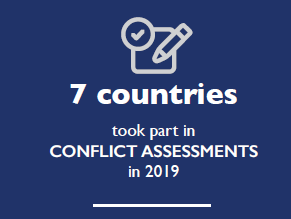Violent conflict and instability affect at least 50 countries and 1.5 billion people worldwide
Drawing on 20 years of experience, the Center for Conflict and Violence Prevention (CVP), located in USAID’s Bureau for Conflict Prevention and Stabilization (CPS), assists USAID Missions and staff overseas to design and deliver state-of-the art conflict mitigation, violence prevention, and peacebuilding interventions. CPS/CVP brings a strong track record of service to the field through conflict and countering violent extremism (CVE) assessments, early-warning and other data analyses, program design support, cadre development and training, and administration of the People-to-People Reconciliation Fund.
Many of the causes of violence, extremism and instability – such as deteriorating economies, weak or illegitimate political institutions, and competition over natural resources – are central concerns of aid.
Our stakes in these countries are high. While global rates of poverty continue to fall, the world’s poor will increasingly be concentrated in fragile and conflict-affected countries, estimated to reach over 50 percent of the global total by 2030. Roughly 80 percent of current humanitarian assistance is aiding people affected by violence and conflict, with the vast majority of this aid spent on protracted crises. Nearly 60 million people, half of them children, have been forced from their homes due to conflict and violence. These crises often spread across borders, and state failure can breed chaos and allow transnational crime and terrorism to flourish. In fact, due to the devastating impact of conflict and fragility on development outcomes, the 2030 Agenda for Sustainable Development elevated peace as a cross-cutting issue and adopted Goal 16 which seeks to promote peace, justice and inclusive societies.
USAID funds programs and activities that work to mitigate and manage the causes and consequences of violent conflict, instability and extremism. We bridge learning with action by formulating policy as well as guidance on program design, monitoring and evaluation.
- In countries experiencing political crises, demonstrating signs of fragility or emerging from conflict, USAID provides conflict assessments and generates analyses on potential drivers of resiliencies to withstand conflict.
- USAID works with other donors and fragile states themselves to develop approaches for improving aid in these areas. This cooperation has led to important advances such as the development of tracking tools to monitor the complexities of conflict affected states specifically.
USAID has:
Development assistance needs new ways of thinking about conflict and how aid in these contexts can be planned and implemented. That is why USAID gives priority attention to conflict and violence prevention.
- Conducted more than 85 conflict-related assessments in approximately 50 countries.
- Trained more than 900 government, interagency and non-government partners in the necessary tools to design programs and ensure a peacebuilding approach in conflict-affected environments since 2012.

